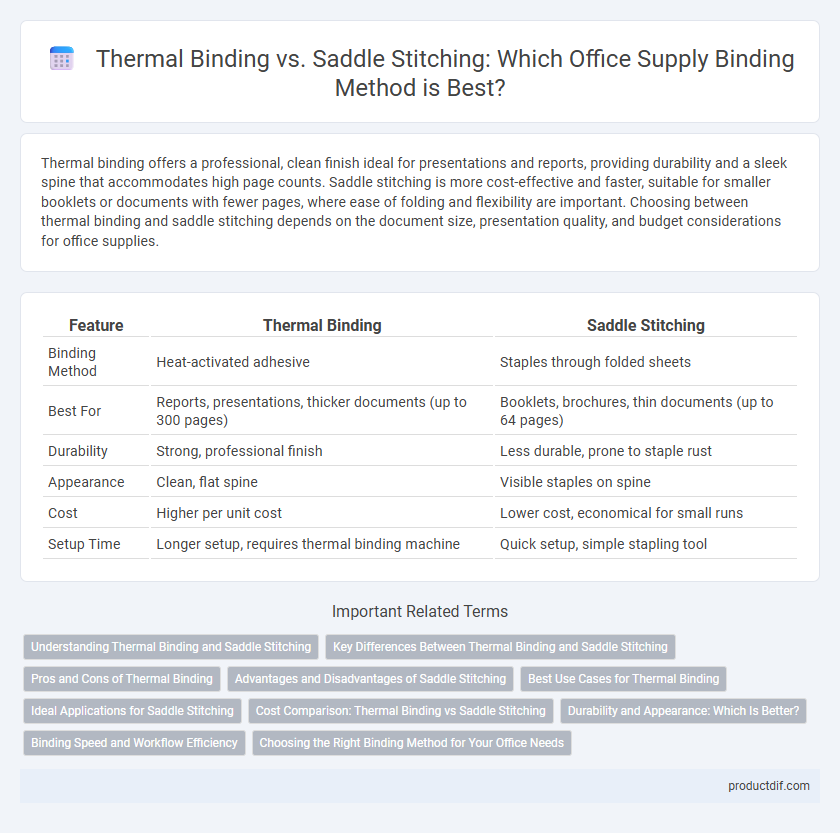Thermal binding offers a professional, clean finish ideal for presentations and reports, providing durability and a sleek spine that accommodates high page counts. Saddle stitching is more cost-effective and faster, suitable for smaller booklets or documents with fewer pages, where ease of folding and flexibility are important. Choosing between thermal binding and saddle stitching depends on the document size, presentation quality, and budget considerations for office supplies.
Table of Comparison
| Feature | Thermal Binding | Saddle Stitching |
|---|---|---|
| Binding Method | Heat-activated adhesive | Staples through folded sheets |
| Best For | Reports, presentations, thicker documents (up to 300 pages) | Booklets, brochures, thin documents (up to 64 pages) |
| Durability | Strong, professional finish | Less durable, prone to staple rust |
| Appearance | Clean, flat spine | Visible staples on spine |
| Cost | Higher per unit cost | Lower cost, economical for small runs |
| Setup Time | Longer setup, requires thermal binding machine | Quick setup, simple stapling tool |
Understanding Thermal Binding and Saddle Stitching
Thermal binding uses heat to fuse the pages and cover into a clean, professional finish ideal for reports and presentations requiring durability. Saddle stitching involves folding sheets and stapling them along the spine, offering a cost-effective and quick solution for booklets and brochures with fewer pages. Choosing between thermal binding and saddle stitching depends on factors like document thickness, appearance preference, and budget.
Key Differences Between Thermal Binding and Saddle Stitching
Thermal binding secures documents using heat-activated adhesive along the spine, creating a clean, professional finish ideal for thicker booklets, while saddle stitching involves stapling sheets together along the fold, suitable for thinner publications such as brochures or magazines. Thermal binding offers greater durability and a polished appearance, whereas saddle stitching allows for quicker, cost-effective production. The choice between thermal binding and saddle stitching depends on document thickness, budget constraints, and the desired aesthetic.
Pros and Cons of Thermal Binding
Thermal binding offers a professional, clean finish ideal for presentations and reports, providing durability and a polished look that resists wear over time. Its main drawback is the lack of flexibility; pages cannot be easily added or removed, making it less suitable for documents requiring frequent updates. Compared to saddle stitching, thermal binding supports thicker documents but requires specialized equipment and longer setup time.
Advantages and Disadvantages of Saddle Stitching
Saddle stitching offers cost-effective binding ideal for small to medium-sized booklets, providing a flat spine that allows for easy photocopying and a professional appearance. However, its main disadvantage lies in limited capacity, as it is unsuitable for thick documents due to the risk of pages falling out and creasing near the fold. This method is best suited for brochures, catalogs, and reports with fewer than 80 pages, emphasizing convenience and simplicity over durability.
Best Use Cases for Thermal Binding
Thermal binding offers a professional, polished finish ideal for business reports, presentations, and manuals requiring durability and high-quality appearance. It is best suited for documents with high page counts, as the adhesive spine securely holds large volumes without risk of pages falling out. Unlike saddle stitching, thermal binding accommodates thicker booklets and ensures a flat spine, making it perfect for office settings where long-term document preservation is essential.
Ideal Applications for Saddle Stitching
Saddle stitching is ideal for booklets, brochures, and magazines with a page count typically ranging from 8 to 64 pages, offering a cost-effective and professional finish. It is best suited for materials that require quick turnaround and light to medium page thickness, ensuring pages lay flat for easy reading. This binding method is commonly used for manuals, catalogs, newsletters, and event programs due to its durability and neat appearance.
Cost Comparison: Thermal Binding vs Saddle Stitching
Thermal binding typically incurs higher initial costs due to specialized equipment and consumables such as thermal covers and glue strips, making it more expensive for small print runs. Saddle stitching, using staples to bind pages, offers a cost-effective solution for shorter documents or high-volume projects with lower material expenses. Businesses aiming for budget-friendly binding methods often prefer saddle stitching to minimize production costs without compromising basic durability.
Durability and Appearance: Which Is Better?
Thermal binding offers superior durability compared to saddle stitching, as its adhesive spine securely holds pages together, making it ideal for documents that require long-term use and professional presentation. Saddle stitching, while providing a neat and cost-effective appearance with staples along the spine, tends to be less durable and is best suited for shorter-length booklets or pamphlets. For a polished, sturdy finish, thermal binding is generally the preferred choice in office supply binding options.
Binding Speed and Workflow Efficiency
Thermal binding offers faster binding speeds by quickly melting adhesive to secure pages, making it ideal for high-volume office workflows requiring rapid document assembly. Saddle stitching involves folding and stapling sheets, which can be slower and less efficient for large batches but is suitable for smaller projects needing minimal finishing time. Choosing thermal binding enhances workflow efficiency by reducing manual handling and enabling consistent, durable results in busy office environments.
Choosing the Right Binding Method for Your Office Needs
Thermal binding offers a professional, durable finish ideal for presentations and reports that require a polished look and long-lasting quality. Saddle stitching is cost-effective and efficient for smaller documents or booklets with fewer pages, making it suitable for quick office tasks or internal use. Evaluate document size, budget, and desired durability to select the binding method that best enhances your office productivity and presentation standards.
Thermal binding vs Saddle stitching Infographic

 productdif.com
productdif.com